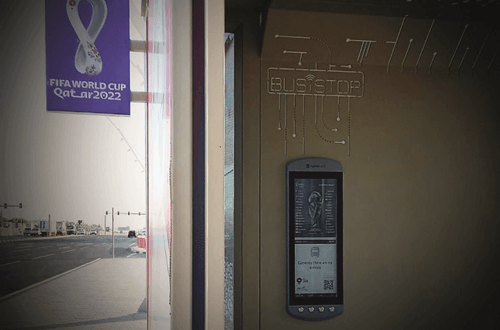
Papercast e-paper displays are providing real-time passenger information and wayfinding as part of critical infrastructure to transport the anticipated 1.5 million visitors between eight stadiums across five cities in Qatar during the 2022 World Cup.
The company believes that the contract is one of the largest single e-paper deployments in the world, as the state invests heavily in an estimated $220bn infrastructure programme as part of the Qatar National Vision 2030, driven by preparations for the FIFA World Cup.
Featuring e-ink screen technology, Papercast was selected to supply 23-inch e-paper displays following a trial period in the extreme climactic conditions of Qatar. The country’s mass public transport system – which comprises metro, tram and bus services – will help fans and tournament organisers to travel between stadiums, hotels and tourist attractions, and the provision of live wayfinding and travel information on digital displays was said to be crucial in facilitating passenger flow, while the preference for e-paper technology supports the tournament’s sustainability strategy to build a sustainable legacy that contributes to the United Nations Sustainable Development Goals.
Robert Bicket, CEO at Papercast: “We are thrilled to be part of the most followed sporting event in the world and an exciting time for Qatar as it works to build the foundations for future growth. We celebrate our largest contracted order to date, and the fact that our e-paper displays were selected to meet the rigorous requirements and challenges that a project of this calibre demands.”
Papercast is a global provider of battery and solar powered e-paper passenger information displays. The company leverages its strength as a technology innovator to continually push the limits of its proprietary hardware and software, while incorporating components from specialist manufacturers where it makes sense – such as the electronic paper screens from inventor E Ink. Perfect for outdoor signage due to its excellent sunlight visibility, Papercast displays can withstand extreme temperatures and can operate on solar powered batteries due to its power effiency. Completely stand-alone, the displays can be easily installed ‘off the grid’ within hours.

